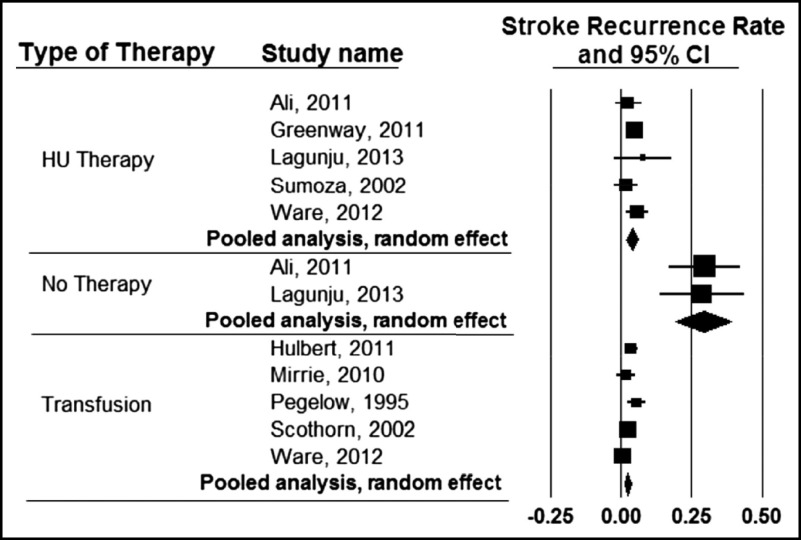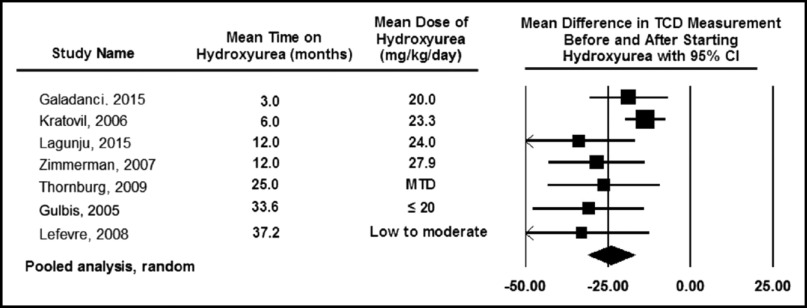Abstract
There is a Blood Commentary on this article in this issue.
TO THE EDITOR:
The COVID-19 pandemic may soon result in an unprecedented decrease in blood supply in the United States. Not only will there be a decrease in blood donors, but there will likely be a decrease in the number of health care personnel able to collect, process, and deliver the blood donations. Conceivably, clinicians will be compelled to ration the limited resources required for blood transfusion to those at immediate risk for clinical deterioration.
Children with sickle cell anemia (SCA) and a history of strokes will be at greatest risk for recurrent stroke without regular blood transfusion therapy. For children with SCA and prior strokes, regular blood transfusion has been standard therapy for stroke prevention for >30 years. The absence of any treatment for secondary stroke prevention can be catastrophic. In a pooled analysis of 2 studies conducted in low-resource settings, children with SCA and strokes who did not receive regular blood transfusion had an overt stroke recurrence rate of 29 per 100 person years, with ≥50% of children having acute stroke recurrence in 2 years1 (Figure 1). For some time, pediatricians in Africa have been challenged with obtaining adequate, safe, and routine blood supply for secondary prevention of strokes and are electing to use hydroxyurea as an alternative. In 2013, Legunju and colleagues in Nigeria were among the first pediatricians to report the benefit of hydroxyurea therapy as an alternative to regular blood transfusion therapy for secondary stroke prevention in children with SCA.2 In a pooled analysis that includes 2 studies conducted in low-income settings, hydroxyurea therapy was far superior compared with no therapy for secondary stroke prevention, with 3.8 and 29 recurrent stroke events per 100 person years, respectively1 (Figure 1).
Figure 1.
Incidence rates of recurrent stroke in individuals with SCD receiving hydroxyurea therapy, blood-transfusion therapy, or no therapy for secondary stroke prevention in published studies. The expected incidence rates of stroke recurrence while on regular blood-transfusion therapy, hydroxyurea (HU) therapy, or no therapy are 1.9 (95% confidence interval [CI], 1.0-2.9), 3.8 (95% CI, 1.9-5.7), and 29.1 (95% CI, 19.2-38.9) events per 100 patient years, respectively. Reprinted from Kassim et al.1
Children with SCA and abnormal transcranial Doppler (TCD) measurements who do not receive regular blood transfusions are also at an increased risk for strokes. The rate of strokes in children with SCA and with abnormal TCD measurements who are not receiving regular blood transfusion therapy is ∼10.7 events per 100 person years, which decreases to 0.90 events per 100 person years with regular blood transfusion therapy.3 Notably, the TCD With Transfusions Changing to Hydroxyurea (TWiTCH) trial provided convincing evidence that children with SCA and abnormal TCD measurements who were initially receiving regular blood transfusion therapy, for ≥1 year, can be transitioned to hydroxyurea therapy at the maximum tolerated dose over a course of ∼6 months.4 Thus, hydroxyurea at maximum tolerated dose is a viable option to no regular blood transfusion for children with abnormal TCD measurements.
Additional evidence bolstering the support of hydroxyurea for primary stroke prevention is based on decreased TCD measurements in children with SCA after starting treatment with hydroxyurea. In 1 study, hydroxyurea was prescribed for 90.9% (110/120) of children ≥5 years of age with SCA; subsequent follow-up, with a median of 4.4 years, revealed that none of these children had abnormal or even conditional TCD measurements5 relative to the expected prevalence ≥ 10%. Equally important, a pooled analysis provides clear evidence that even a moderate dose of hydroxyurea (20 mg/kg per day) lowers TCD measurements to a sustainable response that may occur as early as 3 months after starting therapy (Figure 2).6 Lastly, data from a randomized controlled trial for children with abnormal TCD measurements (NCT02560935) show that an initial low dose of hydroxyurea (10 mg/kg per day) lowers TCD measurements to <200 cm/s in the majority of children 3 months later (M. DeBaun, e-mail, March 2020).
Figure 2.
Pooled analysis of the 7 studies documenting TCD measurements before and after hydroxyurea therapy in children with SCA. The pooled analysis is based on the random-effect model demonstrating the average decrease in TCD measurement after starting hydroxyurea therapy of 25 cm/s (left panel). The table also includes the observation that the decrease in TCD measurements can occur as early as 3 months after starting hydroxyurea therapy, with a sustained impact of hydroxyurea therapy on decreasing TCD measurements for ≥36 months. The black diamond represents the results of random-effect models (right panel). The tips of the diamond represent the 95% confidence interval (CI) of the meta-analyses for the random-effect models. MTD, maximum tolerated dose. Reprinted from DeBaun and Kirkham.6
With the possibility of the COVID-19 pandemic causing blood supply interruptions, a viable solution is to immediately initiate low-dose hydroxyurea therapy (fixed dose, 10 mg/kg per day) for all children receiving blood transfusion therapy for primary and secondary stroke prevention. Subsequently, shared decision-making can be used to determine whether there should be an increase in the dose of hydroxyurea or whether the patient should be maintained at the same dose in the absence of a reliable blood supply or adequate health care personnel required for regular transfusions. Additionally, a formal discussion should occur with the local blood bank leadership to identify strategies for ongoing assessment of blood inventory and unique challenges for specific patients relying on regular blood transfusions.
Three clear advantages occur when immediately starting low-dose hydroxyurea therapy for children already receiving regular blood therapy for primary and secondary stroke prevention. First, low-dose hydroxyurea has a negligible risk for myelosuppression. Thus, the patient will not require routine laboratory surveillance during this challenging interval, although assessment of potential pregnancy will be required, when appropriate, given the concern for the teratogenic potential of hydroxyurea. Second, starting low-dose hydroxyurea therapy will decrease the lag time for clinical benefits of hydroxyurea if blood transfusions are suspended for stroke-prevention therapy. Third, preliminary data indicate that low-dose hydroxyurea therapy decreases the expected incidence rate of acute vaso-occlusive pain and acute chest syndrome events in children7 and adults8 with SCA living in low-resource settings, with minimal to no laboratory surveillance.
The disadvantages of starting low-dose hydroxyurea are small and include the time required to explain the risk-benefit ratio and the inconvenience of picking up the medication. Alternatively, delaying this time-sensitive decision to start hydroxyurea therapy until blood transfusions are no longer electively available will have potentially grievous consequences, because the clinical benefits of hydroxyurea alone require ≥8 to 12 weeks to take effect.
The COVID-19 pandemic is presenting unparalleled challenges in preventing strokes in children with SCA. However, we can easily and immediately implement lessons learned from stroke-prevention studies conducted in Nigeria2,9 and Jamaica.10 Reverse implementation of a promising and tested therapeutic alternative to blood-transfusion therapy in this high-risk population for strokes will be critical for guiding medical care in the United States and Europe.
Based on available evidence, a prudent cautionary step is to immediately start a low dose of hydroxyurea in all children with SCA who receive regular blood-transfusion therapy for primary or secondary stroke prevention. This strategy is far more likely to be of clinical benefit with negligible risks compared with the possibility of no blood-transfusion therapy. Moreover, in the absence of regular blood-transfusion therapy, hydroxyurea treatment will provide the additional benefits of decreasing the incidence rates of acute vaso-occlusive pain and acute chest syndrome events in children with SCA. After starting hydroxyurea, but while still receiving regular blood-transfusion therapy for primary and secondary stroke prevention, the decision to increase the hydroxyurea dose should be made after a discussion with the family and assessment of the local blood supply.
As the knowledge about sickle cell disease (SCD) and COVID-19 continues to evolve, the SCD community is encouraged to review the American Society of Hematology Web site for management of individuals with SCD during the pandemic (https://www.hematology.org/covid-19/covid-19-and-sickle-cell-disease), as well as to enroll participants in the Secure-SCD Registry, Surveillance Epidemiology of Coronavirus (COVID-19) Under Research Exclusion (https://covidsicklecell.org). This registry is designed to capture global pediatric and adult COVID-19 SCD cases and to provide interim summaries of reported cases.
Authorship
Contribution: M.R.D. conceived and wrote this manuscript.
Conflict-of-interest disclosure: The author declares no competing financial interests.
Correspondence: Michael R. DeBaun, Vanderbilt-Meharry Center of Excellence in Sickle Cell Disease, 2525 West End Ave, Suite 750, Nashville, TN 37203-1738; e-mail: m.debaun@vumc.org.
REFERENCES
- 1.Kassim AA, Galadanci NA, Pruthi S, DeBaun MR. How I treat and manage strokes in sickle cell disease. Blood. 2015;125(22):3401-3410. [DOI] [PMC free article] [PubMed] [Google Scholar]
- 2.Lagunju IA, Brown BJ, Sodeinde OO. Stroke recurrence in Nigerian children with sickle cell disease treated with hydroxyurea. Niger Postgrad Med J. 2013;20(3):181-187. [PubMed] [Google Scholar]
- 3.Adams RJ, McKie VC, Hsu L, et al. Prevention of a first stroke by transfusions in children with sickle cell anemia and abnormal results on transcranial Doppler ultrasonography. N Engl J Med. 1998;339(1):5-11. [DOI] [PubMed] [Google Scholar]
- 4.Ware RE, Davis BR, Schultz WH, et al. Hydroxycarbamide versus chronic transfusion for maintenance of transcranial doppler flow velocities in children with sickle cell anaemia-TCD With Transfusions Changing to Hydroxyurea (TWiTCH): a multicentre, open-label, phase 3, non-inferiority trial. Lancet. 2016;387(10019):661-670. [DOI] [PMC free article] [PubMed] [Google Scholar]
- 5.Ghafuri DL, Chaturvedi S, Rodeghier M, et al. Secondary benefit of maintaining normal transcranial Doppler velocities when using hydroxyurea for prevention of severe sickle cell anemia. Pediatr Blood Cancer. 2017;64(7):e26401. [DOI] [PubMed] [Google Scholar]
- 6.DeBaun MR, Kirkham FJ. Central nervous system complications and management in sickle cell disease [published correction appears in Blood. 2016;127(21):2647]. Blood. 2016;127(7):829-838. [DOI] [PubMed] [Google Scholar]
- 7.Sethy S, Panda T, Jena RK. Beneficial effect of low fixed dose of hydroxyurea in vaso-occlusive crisis and transfusion requirements in adult HbSS patients: a prospective study in a tertiary care center. Indian J Hematol Blood Transfus. 2018;34(2):294-298. [DOI] [PMC free article] [PubMed] [Google Scholar]
- 8.Akingbola TS, Tayo BO, Ezekekwu CA, et al. “Maximum tolerated dose” vs “fixed low-dose” hydroxyurea for treatment of adults with sickle cell anemia. Am J Hematol. 2019;94(4):E112-E115. [DOI] [PMC free article] [PubMed] [Google Scholar]
- 9.Galadanci NA, Umar Abdullahi S, Vance LD, et al. Feasibility trial for primary stroke prevention in children with sickle cell anemia in Nigeria (SPIN trial). Am J Hematol. 2018;93(3):E83. [DOI] [PubMed] [Google Scholar]
- 10.Ali SB, Moosang M, King L, Knight-Madden J, Reid M. Stroke recurrence in children with sickle cell disease treated with hydroxyurea following first clinical stroke. Am J Hematol. 2011;86(10):846-850. [DOI] [PubMed] [Google Scholar]




